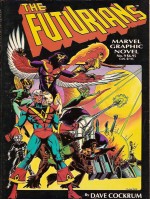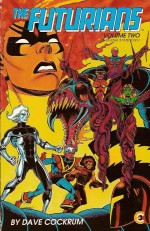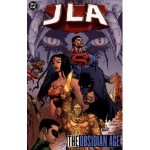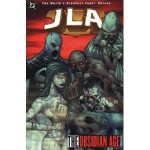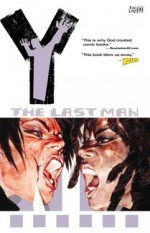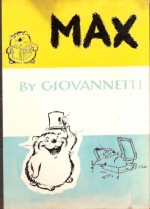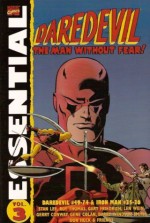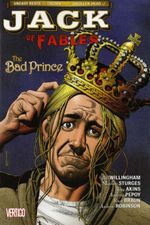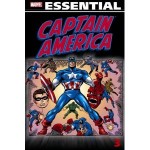
By Stan Lee, Gary Friedrich, Steve Englehart, Gene Colan, John Romita, Gil Kane, Sal Buscema & various (Marvel)
ISBN: 978-0-7851-2166-8
Created by Joe Simon & Jack Kirby in an era of frantic patriotic fervour, Captain America was a dynamic and highly visible response to the horrors of Nazism and the threat of Liberty’s loss. He faded during the post-war reconstruction and briefly reappeared after the Korean War – a harder, darker sentinel ferreting out monsters, subversives and the “commies†who lurked under every brave American kid’s bed. Then he vanished once more until the burgeoning Marvel Age resurrected him just in time for the turbulent, culturally divisive 1960s.
By the time of this third Essential chronicle, gathering issues #127-156 of his monthly comicbook and reprinting the covers to the first two Annuals, the Star-Spangled Avenger had become a uncomfortable symbol of a troubled, divided society, split along age lines and with many of the hero’s fans apparently rooting for the wrong side…
Nevertheless the action begins here with the Sentinel of Liberty still working for super-scientific government spy-agency S.H.I.E.L.D. (which back then stood for Supreme Headquarters International Espionage Law-enforcement Division) in ‘Who Calls Me Traitor?’ (#127, July 1970, by Stan Lee, Gene Colan & Wally Wood), which saw the veteran hero framed and manipulated by friend and foe alike in the search for a double agent in the ranks, after which the embittered avenger dropped out and decided to “discover America†– as so many kids were doing – on the back of a freewheeling motorcycle.
‘Mission: Stamp Out Satan’s Angels!’ (inked by Dick Ayers) saw him barely clear the city limits before encountering a nasty gang of bikers terrorising a small-town rock festival, after which his oldest enemy resurfaced to exact ‘The Vengeance of… the Red Skull’ as a by-product of attempting to begin a Middle East war.
Issue #130 found Cap ‘Up Against the Wall!’ as old foe Batroc the Leaper led Porcupine and Whirlwind in an fully paid-for ambush whilst the Sentinel of Liberty was busy defusing a college riot. The mysterious contractor then resorted to a far subtler tactic: launching a psychological assault in ‘Bucky Reborn!’
With the mystery villain revealed, the tragic true story behind the resurrected sidekick came out in ‘The Fearful Secret of Bucky Barnes!’ – a powerful, complex drama involving ruthless science brokers A.I.M., their murderous master Modok and even Doctor Doom.
Back in New York Advanced Idea Mechanics promptly returned in #133 as Modok attempted to stir racial unrest by sending a killer cyborg to create ‘Madness in the Slums!’ allowing Cap to reunite with his protégé The Falcon – whose name even began appearing in the title from the next issue.
Now a full-fledged partnership Captain America and the Falcon #134 found the pair battling ghetto gangsters in ‘They Call Him… Stone-Face!’, before the Avenger introduced his new main man to S.H.I.E.L.D. in the chilling ‘More Monster than Man!’ (inked by Tom Palmer) wherein a love-struck scientist turned himself into an awesome anthropoid to steal riches, only to end up in ‘The World Below’ (with the legendary Bill Everett applying his brilliant inks to Colan’s moody pencils) as a collateral casualty of the Mole Man’s battle with Cap.
With the Falcon coming to the rescue the Star-Spangled Avenger was on hand when his new partner opted ‘To Stalk the Spider-Man’ – a typical all-action Marvel misunderstanding that was forestalled just in time for Stone-Face to return in #138’s ‘It Happens in Harlem!’ as John Romita the elder returned to the art chores for the beginning of a lengthy and direction-changing saga…
For years Captain America had been the only expression of Steve Rogers’ life, but with this issue the man went undercover as a police officer to solve a series of disappearances and subsequently regained a personal life which would have long-term repercussions. After Spidey, Falcon and Cap trounced Stone-Face, the Red, White and Blue was subsumed by plain Rookie Blues in ‘The Badge and the Betrayal!’ as Steve found himself on a Manhattan beat as the latest raw recruit to be bawled out by veteran cop Sergeant Muldoon…
Meanwhile police officers were still disappearing and Rogers was getting into more fights on the beat than in costume… Issue #140 revealed the plot’s perpetrator ‘In the Grip of Gargoyle!’ as the tale took a frankly bizarre turn with moody urban mystery inexplicably becoming super-spy fantasy as the Grey Gargoyle stole a mega-explosive from S.H.I.E.L.D. in ‘The Unholy Alliance!’ (with Joe Sinnott inks).
Spectacular but painfully confusing until now, the epic was dumped on new writer Gary Friedrich to wrap up, beginning with ‘And in the End…’ (Captain America and the Falcon #142) wherein Cap, renewed love interest Sharon Carter, Falcon and Nick Fury attempted to save the world from the Gargoyle and ultimate explosive Element X…
All this time the Falcon, in his civilian identity of social worker Sam Wilson, had been trying to get friendly with “Black Power†activist Leila Taylor and, with the sci fi shenanigans over, a long-running subplot about racial tensions in Harlem boiled over…
‘Power to the People’ and ‘Burn, Whitey, Burn!’ (both from giant-sized #143 with Romita inking his own pencils) saw the riots finally erupt with Cap and Falcon caught in the middle, but copped out with the final chapter by taking a painfully parochial and patronising stance and revealing that the unrest amongst the ghetto underclass was instigated by a rabble-rousing super-villain in ‘Red Skull in the Morning… Cap Take Warning!’
Nevertheless Friedrich had made some telling and relevant points – and continued to do so in #144’s first story ‘Hydra Over All!’ (illustrated by Romita) with the creation of S.H.I.E.L.D.’s all-woman attack squad Femme Force One (stop squirming – at least they were trying to be egalitarian and inclusive…).
The issue also featured a solo back-up tale ‘The Falcon Fights Alone!’ (drawn by the great Gray Morrow) wherein the street vigilante got a new uniform and rededicated himself to tackling the real problems on his turf; drug-dealers and thugs endangering the weakest, poorest members of society…
Captain America and the Falcon #145 continued the hydra storyline with ‘Skyjacked’ (stunningly illustrated by Gil Kane & Romita) as the terrorists kidnapped Cap’s new team in mid-air, after which Sal Buscema began his long tenure on the series with ‘Mission: Destroy the Femme Force!’ and ‘Holocaust in the Halls of Hydra!’ (inked by John Verpoorten) wherein the devious dealings are uncovered before Falcon comes to the rescue of the severely embattled and outgunned heroes, culminating in the unmasking of the power behind the villainous throne in #147’s ‘And Behind the Hordes of Hydra…’ and a staggering battle royale in Las Vegas as the power behind the power reveals himself in Friedrich’s swansong ‘The Big Sleep!’
Gerry Conway assumed the writing chores for issues #149-152, an uncharacteristically uninspired run that began with ‘All the Colors… of Evil!’ (inked by Jim Mooney) wherein Gallic mercenary Batroc resurfaced, kidnapping ghetto kids for an unidentified client who turned out to be the alien Stranger (or at least his parallel universe incarnation) who intervened personally in ‘Mirror, Mirror…!’ (Verpoorten inks) but was still defeated far too easily.
‘Panic on Park Avenue’ (Buscema & Vince Colletta) pitted Cap against pale imitations of Cobra, Mr. Hyde and the Scorpion as Conway sought to retroactively include Captain America in his ambitious Mr. Kline Saga (for which see Essential Iron Man and Essential Daredevil volumes 4) climaxing with ‘Terror in the Night!’ (inked by Frank Giacoia) featuring bombastic battles and new plot-complications for officer Steve Rogers and Sgt. Muldoon…
Captain America and the Falcon #153 heralded a renaissance and magical return to form for the Star-Spangled Avenger as writer Steve Englehart came aboard and hit the ground running with a landmark epic which rewrote Marvel history and captivated the die-hard fans simultaneously.
The wonderment began with ‘Captain America… Hero or Hoax?‘ (inked by Mooney) as Falcon, Sharon and Cap had an acrimonious confrontation with Nick Fury and decided to take a break from S.H.I.E.L.D.
Sam Wilson went back to Harlem whilst Steve and Sharon booked a holiday in the Bahamas, but it wasn’t long before the Falcon caught Captain America committing racist attacks in New York. Enraged, Falcon tracked him down but was easily beaten since the Sentinel of Liberty had somehow acquired super-strength and a resurrected Bucky Barnes…
In ‘The Falcon Fights Alone!’ (Verpoorten inks) the maniac impostors claimed to be “real†American heroes and revealed what they wanted – a confrontation with the lily-livered, pinko wannabe who had replaced and disgraced them. Even after torturing their captive they were frustrated in their plans until the faux Cap tricked the information out of the Avengers.
Battered and bruised, Falcon headed to the holiday refuge but was too late to prevent an ambush wherein Steve Rogers learned ‘The Incredible Origin of the Other Captain America!’ (Frank McLaughlin inks) – a brilliant piece of literary sleight-of-hand that tied up the Golden Age, fifties revival and Silver Age iterations of the character in a clear, simple, devilishly clever manner and led to an unbelievably affecting conclusion, which perfectly wraps up this glorious black and white compendium in the fabulously gratifying ‘Two into One Won’t Go!’
Any retrospective or historical re-reading is going to turn up a few cringe-worthy moments, but these tales of matchless courage and indomitable heroism are fast-paced, action-packed and illustrated by some of the greatest artists and storytellers American comics has ever produced. Captain America was finally discovering his proper place in a new era and would once more become unmissable, controversial comicbook reading, as we shall see when I get around to reviewing the next volume…
© 1970, 1971, 1972, 2006, 2010 Marvel Characters, Inc. All Rights Reserved.

